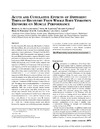Identificador persistente para citar o vincular este elemento:
https://accedacris.ulpgc.es/jspui/handle/10553/76237
| Campo DC | Valor | idioma |
|---|---|---|
| dc.contributor.author | Da Silva-Grigoletto, Marzo E. | en_US |
| dc.contributor.author | Vaamonde, Diana M. | en_US |
| dc.contributor.author | Castillo, Eduardo | en_US |
| dc.contributor.author | Poblador, Maria S. | en_US |
| dc.contributor.author | Garcia-Manso, Juan M. | en_US |
| dc.contributor.author | Lancho, Jose L. | en_US |
| dc.date.accessioned | 2020-12-02T13:56:01Z | - |
| dc.date.available | 2020-12-02T13:56:01Z | - |
| dc.date.issued | 2009 | en_US |
| dc.identifier.issn | 1064-8011 | en_US |
| dc.identifier.other | WoS | - |
| dc.identifier.uri | https://accedacris.ulpgc.es/handle/10553/76237 | - |
| dc.description.abstract | Da Silva-Grigoletto, ME, Vaamonde, DM, Castillo, E, Poblador, MS, Garcia-Manso, JM, and Lancho, JL. Acute and cumulative effects of different times of recovery from whole body vibration exposure on muscle performance. J Strength Cond Res 23(7): 2073-2082, 2009-This experiment was designed to assess the acute (Study I) and cumulative response (Study II) of muscle performance to differing recovery times after exposure to whole body vibration (WBV). All subjects (mean age 19.7 +/- 1.9) were healthy and physically active. In both studies, subjects were exposed to a WBV bout of 6 exposures of 60 seconds each, with frequency of 30 Hz and amplitude of 4 mm. In Study I, subjects (n = 30) underwent 3 trials (1 per day) on different days with a 2-day wash-out period between trials; each trial included either a 1, 2, or 3 minutes of recovery between exposures to WBV. All subjects underwent all trials, which were randomly assigned. Jump ability and muscle power were measured before and after each bout. In Study II, subjects (n = 45) underwent 12 sessions of WBV training in 4 weeks (3 bouts/ wk). The subjects were randomly assigned to 1 of the following 3 groups: WBV with 1-minute recovery periods between exposures, WBV with 2-minute recovery periods between exposures, or control group. Jump ability, muscle power, and strength were measured before and after each bout. In the acute study (I), recovery times of 1 and 2 minutes enhanced all measured parameters (p < 0.05), with the 2-minute recovery being more effective. In the long-term study (II), however, although both periods also enhanced the measured parameters (p < 0.05), the 1-minute recovery proved more effective because the response was modified by systematic stimulation. In conclusion, 2-minute recovery periods provided the most effective acute enhancement of muscle activation, whereas the 1-minute recovery provided a more effective cumulative enhancement of muscle power and jump ability. | en_US |
| dc.language | eng | en_US |
| dc.relation.ispartof | Journal of Strength and Conditioning Research | en_US |
| dc.source | Journal Of Strength And Conditioning Research[ISSN 1064-8011],v. 23 (7), p. 2073-2082, (Octubre 2009) | en_US |
| dc.subject | 241110 Fisiología del músculo | en_US |
| dc.subject.other | Rest Interval Length | en_US |
| dc.subject.other | Short-Term Recovery | en_US |
| dc.subject.other | Skeletal-Muscle | en_US |
| dc.subject.other | Postactivation Potentiation | en_US |
| dc.subject.other | Different Frequencies | en_US |
| dc.subject.other | Muscular Performance | en_US |
| dc.subject.other | Strength | en_US |
| dc.subject.other | Exercise | en_US |
| dc.subject.other | Stimulation | en_US |
| dc.subject.other | Power | en_US |
| dc.subject.other | Training | en_US |
| dc.subject.other | Muscular Strength | en_US |
| dc.subject.other | Muscular Power | en_US |
| dc.title | Acute And Cumulative Effects Of Different Times Of Recovery From Whole Body Vibration Exposure On Muscle Performance | en_US |
| dc.type | info:eu-repo/semantics/Article | en_US |
| dc.type | Article | en_US |
| dc.identifier.doi | 10.1519/JSC.0b013e3181b865d2 | en_US |
| dc.identifier.scopus | 70449440292 | - |
| dc.identifier.isi | 000271569300023 | - |
| dc.contributor.authorscopusid | 23481201700 | - |
| dc.contributor.authorscopusid | 14523595900 | - |
| dc.contributor.authorscopusid | 24764797200 | - |
| dc.contributor.authorscopusid | 6506217589 | - |
| dc.contributor.authorscopusid | 6508074186 | - |
| dc.contributor.authorscopusid | 6603258324 | - |
| dc.identifier.eissn | 1533-4287 | - |
| dc.description.lastpage | 2082 | en_US |
| dc.identifier.issue | 7 | - |
| dc.description.firstpage | 2073 | en_US |
| dc.relation.volume | 23 | en_US |
| dc.investigacion | Ciencias de la Salud | en_US |
| dc.type2 | Artículo | en_US |
| dc.contributor.daisngid | 1417974 | - |
| dc.contributor.daisngid | 2028105 | - |
| dc.contributor.daisngid | 6404688 | - |
| dc.contributor.daisngid | 3398909 | - |
| dc.contributor.daisngid | 1345341 | - |
| dc.contributor.daisngid | 3481542 | - |
| dc.description.numberofpages | 10 | en_US |
| dc.utils.revision | Sí | en_US |
| dc.contributor.wosstandard | WOS:Da Silva-Grigoletto, ME | - |
| dc.contributor.wosstandard | WOS:Vaamonde, DM | - |
| dc.contributor.wosstandard | WOS:Castillo, E | - |
| dc.contributor.wosstandard | WOS:Poblador, MS | - |
| dc.contributor.wosstandard | WOS:Garcia-Manso, JM | - |
| dc.contributor.wosstandard | WOS:Lancho, JL | - |
| dc.date.coverdate | Enero 2009 | en_US |
| dc.identifier.ulpgc | Sí | en_US |
| dc.contributor.buulpgc | BU-FIS | en_US |
| dc.description.jcr | 1,457 | |
| dc.description.jcrq | Q2 | |
| dc.description.scie | SCIE | |
| item.fulltext | Con texto completo | - |
| item.grantfulltext | open | - |
| Colección: | Artículos | |
Citas SCOPUSTM
24
actualizado el 08-jun-2025
Citas de WEB OF SCIENCETM
Citations
21
actualizado el 08-jun-2025
Visitas
95
actualizado el 25-ene-2025
Descargas
271
actualizado el 25-ene-2025
Google ScholarTM
Verifica
Altmetric
Comparte
Exporta metadatos
Los elementos en ULPGC accedaCRIS están protegidos por derechos de autor con todos los derechos reservados, a menos que se indique lo contrario.
